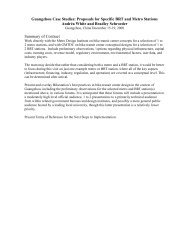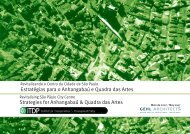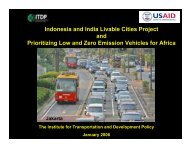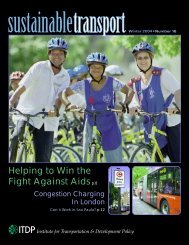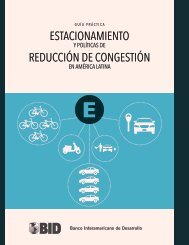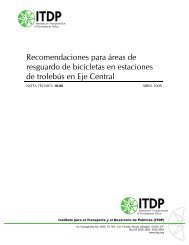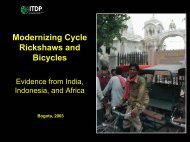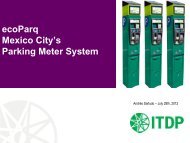Europe's Vibrant New Low Car(bon) Communities - ITDP | Institute ...
Europe's Vibrant New Low Car(bon) Communities - ITDP | Institute ...
Europe's Vibrant New Low Car(bon) Communities - ITDP | Institute ...
Create successful ePaper yourself
Turn your PDF publications into a flip-book with our unique Google optimized e-Paper software.
Executive Summary 7<br />
5. Market sustainable transportation.<br />
Many of these developments make ongoing efforts to reinforce their<br />
founding vision and to empower residents and visitors to make sustainable<br />
travel decisions by offering tailored mobility advice, running<br />
marketing and awareness campaigns, and through promotions such<br />
as free or discounted transit passes or car-sharing membership for<br />
new residents. Ongoing measures to encourage low-emission travel<br />
behavior are important to ensure the long-term transport sustainability<br />
of residents. Planners should consider whether the developers<br />
should be asked to fund these initiatives or if there are ways to create<br />
dedicated streams of revenue (e.g. by earmarking a portion of parking<br />
fees or outdoor advertising fees/space) to fund them over time.<br />
6. Don’t forget the larger policy context.<br />
Transportation policies at the city, regional and national levels play<br />
a key role in shaping daily travel behavior and residential locations<br />
in the longer-term. Congestion charges, citywide parking management<br />
policies, high fuel prices, and high quality transit all influence<br />
mode choice, reinforcing site-specific measures such as car-access<br />
restrictions, provision of high quality walking and cycling facilities<br />
and filtered permeability. All of the case study cities are served by<br />
national railroad systems, providing an alternative to the car for<br />
longer-distance journeys, thereby complementing measures to<br />
discourage car ownership and use in the local area.<br />
A comparative analysis is presented in chapter ten, providing an<br />
overview of TDM measures, details of transit provision and urban<br />
design features, and a summary of key transport-related sustainability<br />
indicators: car ownership, modal split (summarized in Table 2)<br />
and transport-related emissions.<br />
In summary, it was found that private car use accounts for less<br />
than 35% of all trips made by residents in all of the sites (Stellwerk 60<br />
result inferred from distance-based data), a figure that is generally<br />
lower than comparable sites without integrated TDM strategies.<br />
<strong>Car</strong> ownership was found to be no more than 440 vehicles per 1,000<br />
residents in the residential developments, and less than 200 in sites<br />
with priced, limited and spatially separated parking: GWL Terrein,<br />
Stellwerk 60 and Vauban. These sites generate less than 350 kg<br />
of car-related CO 2 per capita per annum, equivalent to savings of<br />
around two thirds compared with their reference areas. These figures<br />
demonstrate both the efficacy of TDM measures and the importance<br />
of building in the right location, close to centers of existing economic<br />
and social activity.<br />
Further Research Needs<br />
Further household research should be conducted to update the case<br />
studies as necessary and to add to the evidence base justifying the<br />
implementation of these policies and practices in Western Europe<br />
and in new developments around the globe. Additional quantitative<br />
research is required to assess both the demand for car-free living<br />
and the financial performance — in terms of rental and property<br />
prices — of heavily car-reduced and car-free areas. This would<br />
encourage local authorities, planners, investors and developers to<br />
be more pro-active in considering this type of development, which<br />
has been shown to reduce car dependence and transport-related CO 2<br />
emissions significantly. Many of the lessons learned are replicable<br />
or adaptable for implementation elsewhere: the task now is to<br />
communicate the successful and transferable policies to politicians,<br />
planners and other relevant stakeholders across the world.





